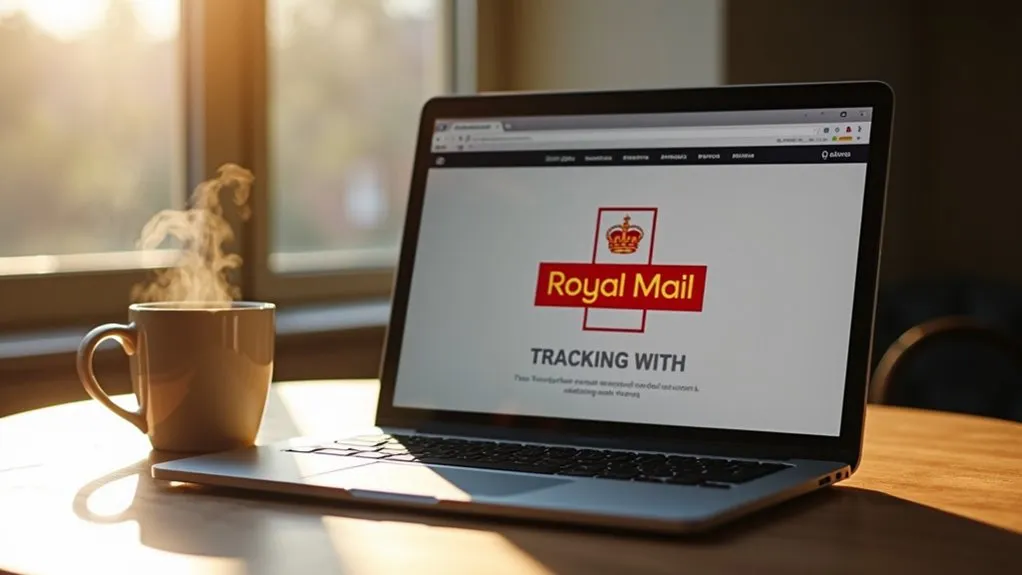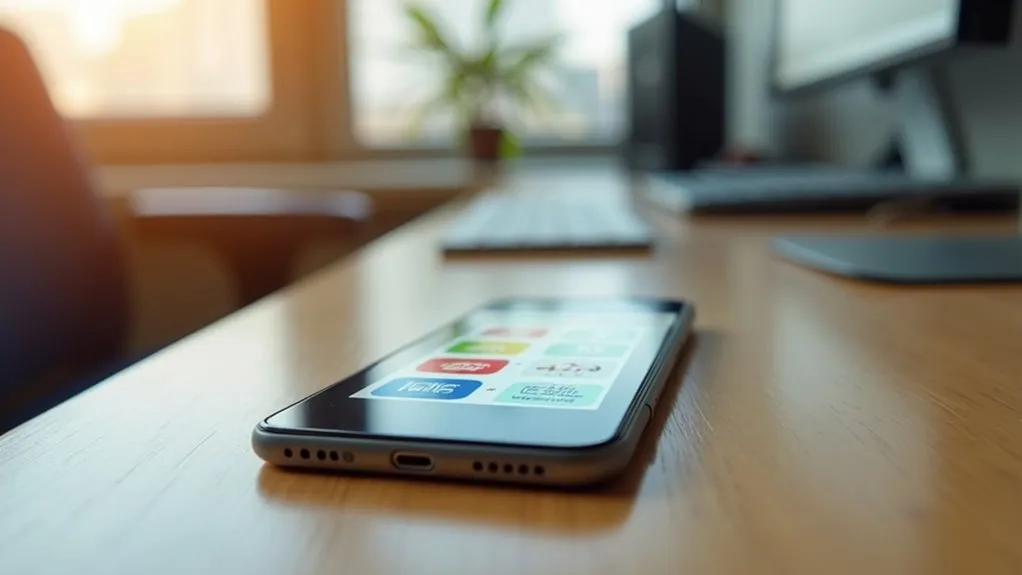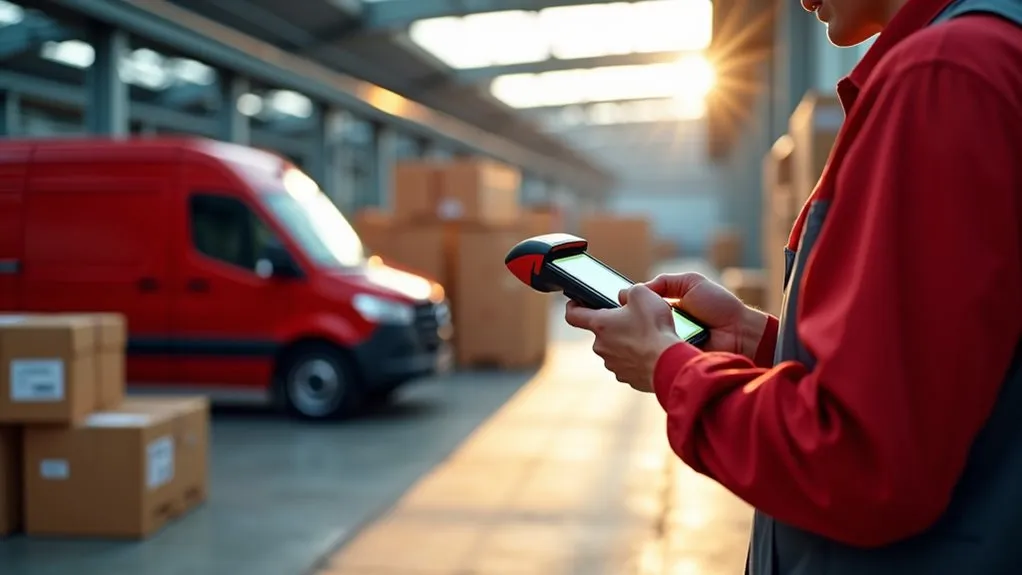Royal Mail Track and Trace simplifies parcel monitoring with a clear 7-step process. Users must first locate their tracking number on receipts or emails. Next, access the Royal Mail website or app. Enter the 9-27 character code accurately. Review real-time status updates like “In Transit.” Explore delivery options such as rescheduling. Set up notifications via SMS or email. Finally, troubleshoot issues using provided guidelines. Uncover deeper insights by exploring further details on this system.
Key Takeaways
- Locate your tracking number on receipts, emails, or shipping labels from Royal Mail.
- Visit royalmail.com/track-your-item to access the Track and Trace portal.
- Enter your 9-27 character tracking code accurately in the search field.
- Review real-time updates like “In Transit” or “Out for Delivery” for status.
- Use notifications via SMS, email, or app for delivery updates.
Finding Your Tracking Number
How can one locate a tracking number for a Royal Mail shipment? For those seeking this crucial identifier, several precise methods exist. First, examine the Post Office receipt, a vital document where the tracking number—often labelled as “reference” or “barcode”—is typically printed under the barcode. Employing effective Receipt Strategies ensures this proof is safeguarded, as the number cannot be retrieved if lost. Alternatively, for online purchases, the tracking number is frequently provided by the retailer in a confirmation email, SMS, or invoice. If absent, initiating Sender Queries by contacting the seller or individual sender is essential to obtain it promptly. Additionally, the number may appear on the parcel’s shipping label, under the barcode or on a tear-off section. For business customers, manifests list reference numbers. These identifiers, ranging from 9 to 27 characters, are critical for monitoring Royal Mail shipments like Tracked 24/48 or International services. Remember, without this number, tracking is unavailable as it serves as the key to accessing parcel status updates.
Accessing the Royal Mail Tracking Tool

Accessing the Royal Mail Tracking Tool begins with locating the appropriate portal, such as the official Royal Mail website at royalmail.com/track-your-item, the Post Office site at www.postoffice.co.uk/track-trace, or the Royal Mail mobile app. Users must then input their unique reference number, typically a 9-27 character code found on receipts or confirmation emails, into the designated field to initiate the process. Once submitted, the system provides detailed status updates on the item’s delivery progress, ensuring transparency and accuracy throughout the journey.
Finding Tracking Portal
Navigating the process of tracking a parcel with Royal Mail begins with locating the appropriate portal for accessing real-time delivery updates. Portal Discovery is crucial, as Royal Mail offers multiple access points like the official website (royalmail.com) with a dedicated tracking page, alongside App Alternatives such as the Royal Mail Mobile App on iOS and Android. Additional options include the Post Office website and third-party tracking sites like Ship24.
Below is a concise overview of tracking portals:
| Platform | Access Point | Key Feature |
|---|---|---|
| Royal Mail Website | royalmail.com/track-your-item | Direct tracking page |
| Royal Mail App | iOS/Android App Store | Barcode scanning |
| Post Office Website | postoffice.co.uk/track-trace | Royal Mail integration |
| Third-Party Sites | Ship24, Parcel Monitor | Multi-carrier tracking |
| Direct URL/API | Custom tracking links | Business integration |
Entering Reference Number
Individuals seeking to monitor their Royal Mail parcels must move from identifying the appropriate tracking portal to inputting the necessary details for real-time updates. On the Royal Mail website, users should navigate to the “Track Your Item” section, locate the input field, and accurately enter their reference number, which ranges from 9 to 27 alphanumeric characters. Format Variations, such as JV620553954GB or AA123456789GB, must be entered precisely as provided on receipts or emails. For Alternative Inputs, third-party platforms like Ship24 or the Royal Mail app also accept these numbers in designated search fields. Users must avoid errors by double-checking the number against official sources, ensuring it corresponds to a trackable service before submission for accurate results.
Viewing Status Updates
The Royal Mail tracking system offers a robust platform for users to monitor their parcels with precision through the dedicated ‘Track and Trace’ page on the official website or the mobile app, available for both iOS and Android devices. Once a tracking number is entered, individuals can access real time monitoring, ensuring they stay informed about their parcel’s journey.
Key features of status visualization include:
- Live Updates: View current statuses like “In Transit” or “Out for Delivery.”
- Progress Tracking: Monitor domestic and international parcel movement.
- Detailed Notifications: Receive push, email, or SMS alerts on key events.
- Visual Proof: Access delivery photos or signatures for certain services.
This ensures clarity and control over parcel tracking.
Entering Your Parcel Details
When engaging with the Royal Mail Track and Trace system, users must first locate their tracking number, a unique identifier ranging from 9 to 27 characters, typically found on a Post Office receipt, item label, or sender’s confirmation email. This reference, also known as a tracking ID or barcode, must be entered precisely into the designated field on the Royal Mail website or app under the “Track Your Item” section. Ensuring the accuracy of the inputted details is critical, as discrepancies can prevent successful tracking of the parcel’s status.
Finding Tracking Number
How can one locate the elusive tracking number essential for monitoring a Royal Mail parcel? This critical alphanumeric code, often 9 to 27 characters, is the gateway to parcel updates. Senders may find it on postage receipts, item labels, or shipping manifests, while recipients can retrieve it from sender emails, SMS, or online order confirmations. Tracking Security ensures safe monitoring, though Privacy Concerns remind users to safeguard this identifier.
Key sources for locating the number include:
- Postage Receipt: Check the Post Office® receipt for the code.
- Shipping Label: Inspect the tear-off section on the parcel.
- Sender Communication: Review emails or SMS from the sender.
- Online Accounts: Access order history on retailer platforms for details.
Inputting Correct Details
Navigating the process of entering parcel details for Royal Mail tracking demands meticulous attention to accuracy. Users must access the ‘Track your item’ section on the Royal Mail website or app and input the unique tracking or reference number, which ranges from 9 to 27 characters. Input Accuracy is critical; double-checking for typos, such as confusing ‘O’ with ‘0’, prevents errors. Detail Verification ensures the number, found on receipts or sender confirmations, is correct before submission. After entry, clicking ‘Track your delivery’ may prompt a CAPTCHA for human verification. If issues arise, like ‘number not recognised’, users should confirm the number’s validity and retry later if needed, ensuring seamless tracking through Royal Mail’s precise system.
Reviewing the Status Updates

Understanding the status updates provided by Royal Mail’s Track and Trace system is essential for senders and recipients alike to monitor a parcel’s journey with accuracy. Status Interpretation is critical to grasp terms like “In transit” or “Ready for delivery,” which indicate specific stages in the delivery process. Equally important are Delay Factors, such as customs holds or system issues, which can impact timelines and require patience.
Navigating Royal Mail’s Track and Trace updates is vital for tracking parcels accurately, understanding statuses like “In transit,” and anticipating delays.
Key status insights include:
- Initial Scan: “We’ve got it” confirms the parcel is in Royal Mail’s network.
- Transit Progress: “Item Received” or “Departed waypoint” shows movement through hubs.
- Delivery Phase: “Due to be delivered today” signals imminent arrival.
- Exceptions: “Held at overseas depot” indicates potential delays.
Exploring Delivery Options

What options exist for managing parcel delivery with Royal Mail when circumstances change or standard delivery isn’t suitable? Royal Mail offers a range of Delivery Alternatives to accommodate varying needs with precision. Recipients can reschedule delivery to a preferred day via the app or online, or redirect parcels to a trusted neighbour or local Post Office branch at no extra cost. For added convenience, Safeplace Choices allow nomination of a secure, weatherproof location on one’s property, accessible to postal workers yet discreet, applicable to non-signature items like Tracked 24/48.
Further flexibility includes redelivery to the original or an alternative local address within the same postcode, or collection from a Delivery Office with valid ID. Options like Parcel Collect or Local Collect via retailers enhance accessibility. These meticulously designed solutions ensure parcels are managed effectively, aligning with recipients’ schedules and preferences without compromising security or reliability.
Setting Up Notifications
As parcel tracking becomes increasingly integral to modern delivery experiences, Royal Mail provides a robust system for setting up notifications to keep both senders and recipients informed at every stage. The service offers diverse Notification Channels, including SMS, email, and push notifications via the Royal Mail app, ensuring users stay updated on key parcel journey milestones like posting, delivery attempts, and successful delivery.
Royal Mail’s robust parcel tracking system keeps senders and recipients updated via SMS, email, and app notifications at every delivery stage.
For effective Preference Management, Royal Mail allows tailored setups. Consider these critical aspects:
- Channel Selection: Choose SMS, email, or app notifications based on convenience.
- Sender Enablement: Senders can activate alerts for recipients during booking, especially for Tracked 24/48 or International services.
- App Integration: Download the Royal Mail app to manage preferences and enable push notifications.
- Recipient Control: Recipients can opt into notifications if contact details are provided.
This structured approach ensures seamless communication for all parties involved in the delivery process.
Troubleshooting Tracking Problems
While Royal Mail’s Track and Trace system is designed for reliability, users may occasionally encounter issues that disrupt the tracking process. Common problems include invalid tracking numbers, which should be verified for typos or correct format (e.g., two letters, nine digits, ending with GB). Updates may also stall due to system outages, operational delays like holidays, or missed scans during transit.
Further challenges arise with statuses like “Sender Preparing Item,” indicating the parcel hasn’t entered Royal Mail’s network yet—users should allow 24-48 hours for updates. For International Issues, tracking might cease once an item leaves the UK; checking the destination country’s postal site or Royal Mail’s International Incident Bulletin for delays is advised. In cases of Delivery Disputes, such as “Delivered” status without receipt, users must confirm the address, check safe places, or contact the sender for investigation, ensuring swift resolution of discrepancies.

 Tiếng Việt
Tiếng Việt 日本語
日本語 中文 (中国)
中文 (中国) 한국어
한국어